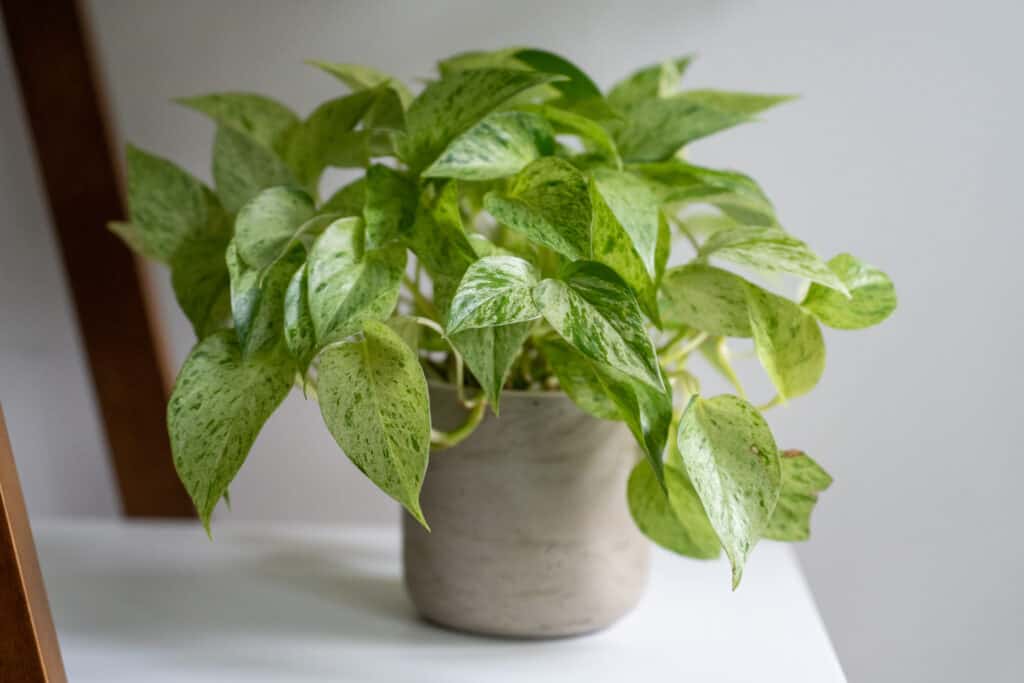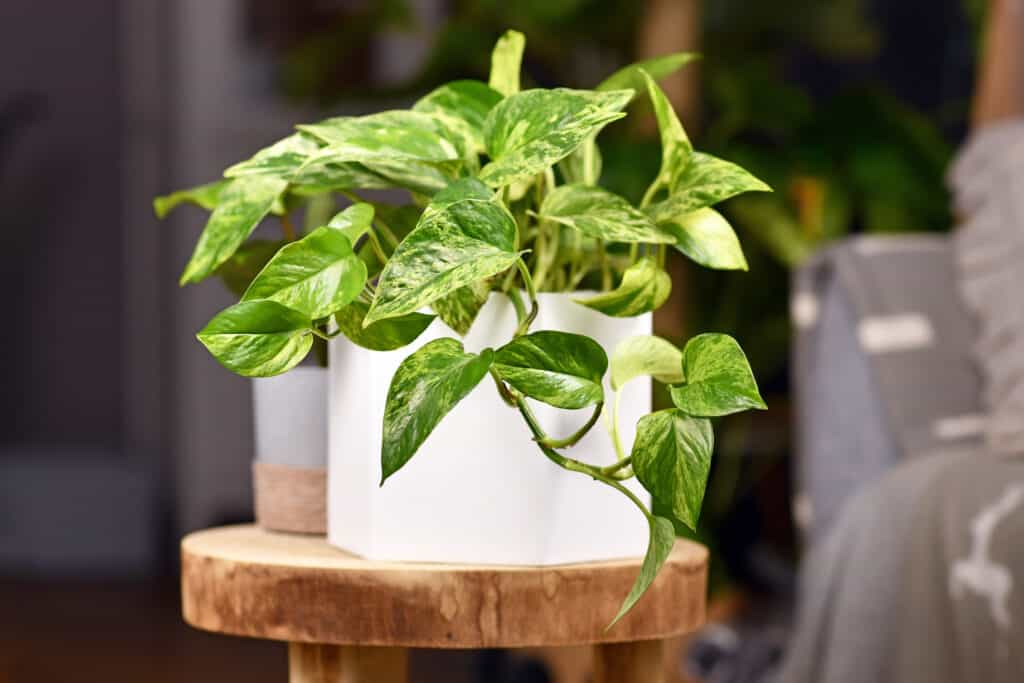If you have pothos house plants, you may wonder if these lovely vines will ever flower. Well, the short answer is that pothos plants grown indoors are juvenile plants not capable of producing flowers. However, pothos can enter maturity and produce flowers in suitable growing conditions.
In this guide, we’ll cover what prevents houseplant pothos from entering their mature phase, how they can reproduce without flowering, and what conditions are necessary in the wild to allow them to produce blooms. Finally, we’ll look at what triggers flowering in mature pothos.
Pothos as a Houseplant

Pothos produce flowers in mature adult stages but rarely while indoors.
©iStock.com/Jenny Sun
Cultivated pothos plants remain in the juvenile or vegetative stage of their perennial life cycle. They typically survive about 10 years in this stage before the plant dies. During this life cycle stage, the plant focuses on the overall growth of its roots, leaves, and stems.
This vine typically reaches 6 to 10 feet long as a juvenile houseplant. Its leaves are heart-shaped, bright, and waxy with smooth, entire margins. Leaf color and variegation depend on the variety and can include bright green to light green with yellow or white variegation (striping). The size of indoor pothos leaves typically ranges from 4 to 8 inches long.
Can Indoor Pothos Plants Reproduce?
The roots of pothos plants do not grow large enough or have the necessary requirements indoors to trigger the hormones responsible for flower production. Additionally, these plants need to reach at least 10 years of age before they’re able to produce blooms. Generally, most indoor pothos plants don’t live past this age.
Now, while juvenile pothos plants don’t reproduce via the formation of flowers, they can clone themselves through vegetative reproduction. In this form of asexual reproduction, a new plant grows from a fragment of the parent plant. This is how you can propagate new pothos plants via cuttings of the original plant.
Outdoor-Grown and Wild Pothos Plants

A row of pothos plants on a shelf.
©Amir Hafidz/Shutterstock.com
While juvenile pothos plants won’t produce blooms, mature plants growing in suitable outdoor conditions and of at least 10 years of age certainly can. The most successful bloomers are pothos plants that grow in their wild habitats. So, where do they natively grow? These tropical vines are native to the Polynesian islands of the South Pacific. Over time, they have naturalized to tropical regions across the world.
In these environments, this plant can look drastically different from the form it takes as a houseplant. In suitable outdoor settings, this vine can grow up to 60 feet long with individual leaves up to 30 inches wide and 36 inches long! The shape of these enormous leaves also differs in their mature phase. Rather than having smooth, entire margins, the leaves become deeply lobed along the margin. As they mature, the leaves can even split all the way up to the mid-rib! Additionally, the shape often changes from distinctly heart-shaped to oval shape.
What Triggers Flowering in Outdoor Pothos Plants?
To flower, this plant needs to reach full maturity and grow in a suitable environment. As a tropical plant, these conditions are humidity levels above 60%, consistent temperatures of 70-90 degrees F, bright but indirect sunlight, well-draining but moist soil, and plenty of space for this vine to spread its roots and foliage. Typically, you won’t see a wild pothos bloom until it has reached at least 35 feet in length.
Once a pothos reaches maturity and grows in a suitable climate, a flower-producing hormone, gibberellin, is activated, triggering flower production.
When these plants flower, they produce a spathe and spadix. A spathe is a large leaf-like, hull-shaped bract. This bract surrounds the spadix, a thick spike covered in tiny flowers. A mature pothos plant produces a cream to light yellow-colored spathe up to 9 inches tall halfway around a cream-colored spadix. Once the plant is ready for pollination, the spathe disintegrates, leaving the spike-like spadix fully exposed.
Do Mature Pothos Plants Always Flower?

If you’re growing pothos plants outside, it’s best to ensure they’re somewhat contained, as they can be invasive and overwhelm the trees they grow on.
©iStock.com/Firn
So, even in ideal conditions, mature pothos plants often don’t consistently produce blooms, and botanists consider these vines “shy-flowering.” The current understanding of why these plants don’t frequently flower, even in outdoor tropical environments, is that they do not produce enough gibberellin, the hormone that catalyzes flower production.
While these vines may be flower-shy, they frequently clone themselves via vegetative reproduction. These plants are masters of this reproduction style and quickly grow new roots as they spread, especially in high-moisture environments. If you’re growing pothos plants outside, it’s best to ensure they’re somewhat contained, as they can be invasive and overwhelm the trees they grow on.
Up Next:
Thank you for reading! Have some feedback for us? Contact the AZ Animals editorial team.








